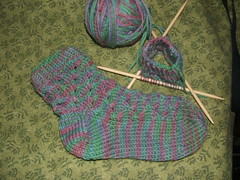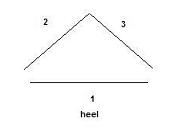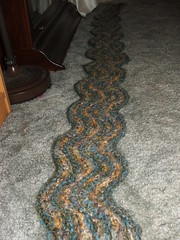Beyond the basics: an introduction to lace, cable, and colorwork
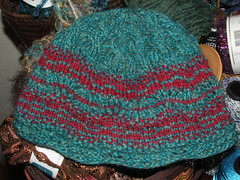
The purpose of this pattern is to introduce to the concept of circular knitting while using basic lace, colorwork, and cabling techniques. This hat will be completed in phases, with only one technique learned per phase. Although the appearance of the hat may seem complicated, this pattern emphasizes how the very simplest combination of stitches can make it look as though you did more work than you really did!
Pattern notes:
Each round gives a set of instructions. Repeat this set of instructions until you get to the end of the round.
Abbreviations:
mc : Main Color, cc: Contrast Color (pay attention to when this is noted in the pattern!)
k: knit, p: purl
yo: Yarn over
k2tog: knit two together, p2tog: purl two together
rnd: round
C6F: 6 stitch forward cable (more on this later)
C4F: 4 stitch forward cable (ditto)
Gauge: 5.5 st/inch and 8 rows/inch over stockinette stitch
Needles: US #6 (4mm) 16” circular and same size dpn (or size needed to get gauge!), cable needle
Yarn: 2 skeins Cascade 220 (light worsted weight) in different colors.
This should be enough to make 2 hats, provided you swap the main and contrast colors for the second hat
Phase 1: Casting on, joining into the round, and a VERY simple lace pattern
Cast on 96 stitches using long-tail method.
Purl one row.
Why did we purl one row before joining into a round? Because this helps eliminate the chance that the stitches will be twisted when they are joined into a circle. OK, take a deep breath- now we will join into a round. At this point, place a marker so that you know when the round begins and ends. We will start the hat with a simple lace stitch referred to as “Old Shale” or “Feather and Fan”.
Round 2: knit
Round 3: (k2tog) twice, (yo, k1) four times, (k2tog) twice to end of round.
Rnd 4: purl
Rnds 5 & 6: knit
Rnd 7: as Rnd 3
Rnd 8: purl
Rnd 9: k1, p1 to end
Phase 2: playing with color
Here we will not only see how cool it looks when you combine colors with knit and purl stitches, but also get a feel for stranded colorwork (often referred to as “Fair Isle”) using a very simple pattern.
Notes for stranding colors:
Do not pull the strands too tight when changing colors, but do not leave them too loose either! Just use the tiniest bit of tension when changing to the next color. The same goes for when carrying the yarn vertically up the work.
Choose which yarn to keep on top and on bottom. For example, I always bring the contrast color up from under the main color when working with two strands. This makes the work look neater and you avoid a tangled mess.
Rnd 10: with contrast color (cc), p1, k1 to end
Rnd 11: k with mc
Rnd 12: k with cc
Rnds 13-15: follow three rounds of color chart
(Say what? What is a color chart and why should I follow it ?!? A color chart is used in most 2-strand color patterns to show what to do while not having to use a bunch of words to do it. Our color chart shows a repeat of 6 stitches and 3 rows. When working in the round, charts are read FROM RIGHT TO LEFT and BOTTOM TO TOP.
Here is the chart for our hat:
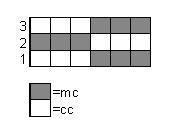
(Each square in the chart represents one stitch. For example, in the first row, you knit 3 stitches with the mc, then 3 with the cc until the end.)
Rnds 16 & 17: k with cc
Rnd 18: k1, p1 with mc
Rnd 19: p1, k1 with cc
Phase 3: you’ve been here before- more lace and colorworkThe next 8 rounds are very much the same as those we started with (Old Shale stitch)
Rnds 20 & 21: knit with mc
Rnd 22: as Rnd 3
Rnd 23: knit with cc
Repeat these four rnds, all with mc (rnds 24-27)
Rnd 28: k1, p1 with cc
Rnd 29: knit with cc
Rnds 30 & 31: work first two rows of color chart
Rnds 32 &33: knit with cc
Rnd 34: k1, p1 with mc
Rnd 35: p1, k1 with cc (cut cc at this point, leaving a 6” tail for weaving in later. All rnds from this point are worked with mc.)
Rnds 36-39: as rnds 24-27)
Phase 4: A little bit of cabling, and the light at the end of the tunnel
OK, we are nearing the end. Really. This is the part where we begin shaping the top of the hat by decreasing stitches. This is also the point where we will need to use double-pointed needles since their will be less stitches (the pattern will tell you when to make the transition). It is possible to make hats just by knitting one big tube and drawing it together at the top. However, it looks much more elegant to shape it a bit (and it’s pretty easy, so why not?)
Before actually decreasing stitches, will start out by learning a very basic cable. Because cables draw in the fabric somewhat, this is also the first step in the decreasing process. OK. Take a deep breath- we need to lay the groundwork for the cables first so that we have some stitches to work with. To do this, on the next six rounds, you will:
K6, p2 (rnds 40-45)
Note: On Rnd 45, work sts onto three dpn’s such that there are 32 st on each needle. At this point, you will not be able to keep the marker on the needles to denote the beginning of the round. Simply thread a piece of yarn through the knitting at this point so that you can keep your place.
On working with dpn’s: On the first stitch on each needle, pull the yarn tighter than usual to avoid getting ladders up your knitting.
Rnd 46: C6F, p2
(OK, this is the first cable round and C6F means 6-stitch forward cable. To do this, you will slip 3 stitches to the cable needle and hold them in the front of the work. Then, you knit the next three stitches off of the primary needle. Then, knit the stitches off the cable needle. See how the column of stitches got twisted? Congrats! You made a cable ;-) Then, purl the next two stitches and repeat the whole shebang to the end of the round.)
Rnd 47: k6, p2
Rnd 48: k2, k2tog, k2, p2 (84 st rem)
Rnd 49: k5, p2
Rnd 50: k1, k2tog, k2, p2 (72 st rem)
Rnd 51: k4, p2
Rnd 52: C4F, p2
(A 4-stitch forward cable is just like a 6-stitch- just worked over fewer sts! To do this, you will slip 2 stitches to the cable needle and hold them in the front of the work. Then, you knit the next two stitches off of the primary needle. Then, knit the stitches off the cable needle.)
Rnd 53: k4, p2tog (60 st rem)
Rnd 54: knit
Rnd 55: k4, p2tog (50 st rem)
Rnd 56: knit
Rnd 57: k3, p2tog (40 st rem)
Rnd 58: knit
Rnd 59: k2, p2tog (30 st rem)
Rnd 60: knit
Rnd 61: k1, p2tog (20 st rem)
Rnd 62: knit
Rnd 63: k2tog (10 st rem)
Draw yarn though remaining st and tie off. Weave in ends and block. You’re done!!!!





